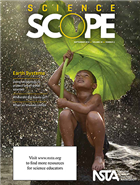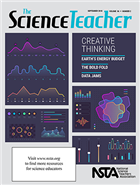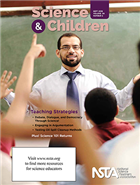Ideas and inspiration from NSTA’s September 2018 K-12 journals
By Mary Bigelow
Posted on 2018-09-18
Whether you’re looking for ideas on systems thinking, adding strategies to your teaching repertoire, or creativity in science, this month’s K-12 journals have it all. Regardless of what grade level or subject you teach, check out all three journals. As you skim through the article titles and description, you may find ideas for lessons that would be interesting your students or the inspiration to adapt a lesson to your heeds or create/share your own.
NSTA members, as always, have access to the articles in all journals! Click on the links to read or add to your library.
 Science Scope – Earth Systems
Science Scope – Earth Systems
From the Editor’s Desk: Earth: The Ultimate Recycler “…I’ve found students don’t always easily comprehend the importance or the mechanisms behind geoscience processes. Even something as simple as the water cycle is fraught with misunderstanding as students tend to harbor ideas that range from thinking that the water coming from various sources in their house differs in terms of its potability, to thinking that the water from a water bottle has never been part of the water cycle.”
Articles in this issue that describe lessons (many of which use the 5E model) include a helpful sidebar documenting the big idea, essential pre-knowledge, time, safety issues, and cost. The lessons also include connections with the NGSS.
- Classroom-Scale Experiments in System-Scale Modeling With Application to the Global Cycle of Water and Energy shows how to connect modeling with experimentation, using energy flow in the water cycle as a context.
- Expand students’ knowledge and experiences of plate tectonics. Getting Beneath the Surface has a series of five activities that model how plate move.
- Students are interested in weather and weather patterns. The unit documented in When Air Masses Collide! Incorporates seven “investigations” (the last is a culminating assessment) on predicting the weather based on several variables.
- From the layers of the Grand Canyon to the hoodoos of Bryce Canyon, our National Parks have fascinating rock formations. The lesson in National Parks Investigation integrates learning about types of rocks and the rock cycle with exposure to the resources of the National Park system.
- Integrating Technology: Using Science and Technology to Protect Urban Water Sources involves students in an investigation of urban water quality. The authors share a graphic organizer/worksheet for students to compare data on two cities.
- Classic Lessons 2.0: Where Did the Leaves Go? updates a traditional lesson into a 5E investigation on how leaves decompose. The article includes examples of student work and suggestions for implementation.
- Teacher To Teacher: Using Phenomena to Drive Student Questions incorporates student questions and misconceptions about flooding in urban areas.
- Turn cloud gazing into Citizen Science: Cloudy With a Chance of “Cirrus” Science, using a NASA app.
- Graphs summarize and present data. If your students need a refresher on graphing,, Interdisciplinary Ideas: Data Literacy 101 has suggestions on choosing effective graphs for a variety of purposes and types of data.
- Scope on the Skies: Ozone: The Protective Layer Above Us has a refresher on the effects of ozone on climate.
These monthly columns continue to provide background knowledge and classroom ideas:
- Disequilibrium: The Connection Between Weather and Air Masses
- Science For All: Creating a Culturally Responsive Middle School Science Classroom
- Teacher’s Toolkit: Community Connections: Involving family in homework.
For more on the content that provides a context for projects and strategies described in this issue, see the SciLinks topics Air Masses, Biotic/Abiotic Factors, Clouds, Decomposers, Ecosystems, Flooding and Society, Floods, Greenhouse Effect, Ozone, Phases of Matter, Plate Tectonics, Rock Classification, Rock Cycle, UV Index, Tornadoes, U.S. National Parks, Water Cycle, Water Quality, Watersheds, Weather, Weather Forecasting
Keep reading for The Science Teacher and Science & Children.
The Science Teacher – Creative Thinking

Editor’s Corner: Creative Science “Problem- and project-based learning, authentic engineering tasks, and student-centered inquiry can all involve students in creative, complex problem-solving and design. And, Job security increasingly requires imagination and creativity. As routine tasks become digitized and automated, successful workers will be those who imagine and create. “
The lessons described in the articles include a chart showing connections with the NGSS. The graphics are especially helpful in understanding the activities and in providing ideas for your own investigations.
- Earth’s Energy Budget focuses on the relationships between energy, greenhouse gases, aerosols, and temperature. The article includes a description of the Energy Budget Model and samples of student explanations.
- Learning Biology Through Molecular Storytelling uses a storytelling approach along with data from the Protein Data Bank (URL provided) to help students connect the shapes of biomolecules with their functions.
- In The Bold Fold activity, students create protein models while studying transcription, translation, and protein folding. The authors include their research on student learning using this model.
- There are stories in every data set. Data Jams has advice on using a model to improve students’ data literacy, analyze scientific research, and share their findings. The authors share their experiences and include photographs of student projects.
- Infographics are another form of story telling. Creative Visual Representation shows how students can synthesize data sources to support a claim in a visual format. The examples provided show infographics as alternatives to research papers, in poster sessions, and as reinforcement.
- In addition to Focus on Physics: Making Sense of Distribution Curves, the author includes action research on the distribution of grades as a context/example.
- Artists can apply their talents in science, as described in Career of the Month: Medical Artist.
These monthly columns continue to provide background knowledge and classroom ideas: Right to the Source: Coloring the Russian Empire One Photograph at a Time
For more on the content that provides a context for projects and strategies described in this issue, see the SciLinks topics Biomolecules, Blackbody Radiation, Climate Change, Communication Skills, DNA, Energy in the Atmosphere, Eukaryotic Cell Structures, Graphing Data, Organelles, Proteins, Sickle Cell Disease, Transcription, Translation, UV Index
 Science & Children – Teaching Strategies
Science & Children – Teaching Strategies
Editor’s Note: Finding a Way — With so much going on in the classroom, above and below the surface, a teacher needs to have a wheelbarrow full of strategies to help deal with the expected and not-so-expected events.
The lessons described in the articles have a chart showing connections with the NGSS. Many are based on the 5E (or 7E) model and include classroom materials, illustrations of student work, and photographs of students engaged in the activities.
- Don’t get turned off by the title! Killing Two Birds With One Stone describes ways to integrate reading/writing with science through interactive notebooks. Samples of student pages are included.
- Science Is “RAD” also addresses notebooking, including strategies for helping students with disabilities or who need additional support. (RAD is a mnenomic for Record-Analyze-Develop an Explanation as a writing strategy).
- Asking questions about meaningful issues can involve elementary students. Debate, Dialogue, and Democracy Through Science! incorporates the Socioscientific Issues framework to increase students’ “science content knowledge, understanding of the nature of science, quality of argumentation abilities, and characteristics for global citizenship, including empathy and perspective taking” The sample lesson shows students learning about the characteristics and value of wetlands using hands-on activities and trade books.
- Engaging in Argumentation shows how argumentation and the 5E model can be integrated, including suggestions for students who are English Language Learners. A useful diagram illustrates the integration, along with graphic organizers and photos of student work.
- Testing Oil Spill Cleanup Methods Ethically incorporates engineering practices and discussion about ethics as students design strategies to clean up an oil spill.
- Engineering Encounters: The Soda Can Crusher Challenge also involves students in the engineering design process.
- The author of The Early Years: Begin With Open Exploration where students “acquire hands-on knowledge of what they know and begin to wonder, think, and raise questions.” The included lesson Exploring Isopods has an example of this open exploration.
- In addition to recommending trade books, Teaching Through Trade Books: Biological Diversity: In the Present and in the Past has lessons on Honing Into Habitats (K-2) and Looking at Living Fossils (3-5).
- Methods and Strategies: Hiding in Plain Sight also addresses integrating literacy and 5E science lessons through trade books.
These monthly columns continue to provide background knowledge and classroom ideas:
- Teaching Teachers: Seeing the Struggle and Reaping the Rewards — A Pathway for Beginning to Explore the Next Generation Science Standards
- The Poetry of Science: Teaching Strategies
- Science 101: How Can I Make Science Fun and Have Students Learn More By Using Phenomenon-Based Learning? (a Background Booster for teachers on electric circuits, magnets, speed and motion)
For more on the content that provides a context for projects and strategies described in this issue, see the SciLinks topics Biodiversity, Buoyancy, Electric Current, Fishes, Food Chains, Forces and Motion, Fossils, Habitats, Insects, Magnets, Plant Growth, Reading and Writing in Science, Water Quality, Wetlands
Disclaimer: The views expressed in this blog post are those of the author(s) and do not necessarily reflect the official position of the National Science Teaching Association (NSTA).


